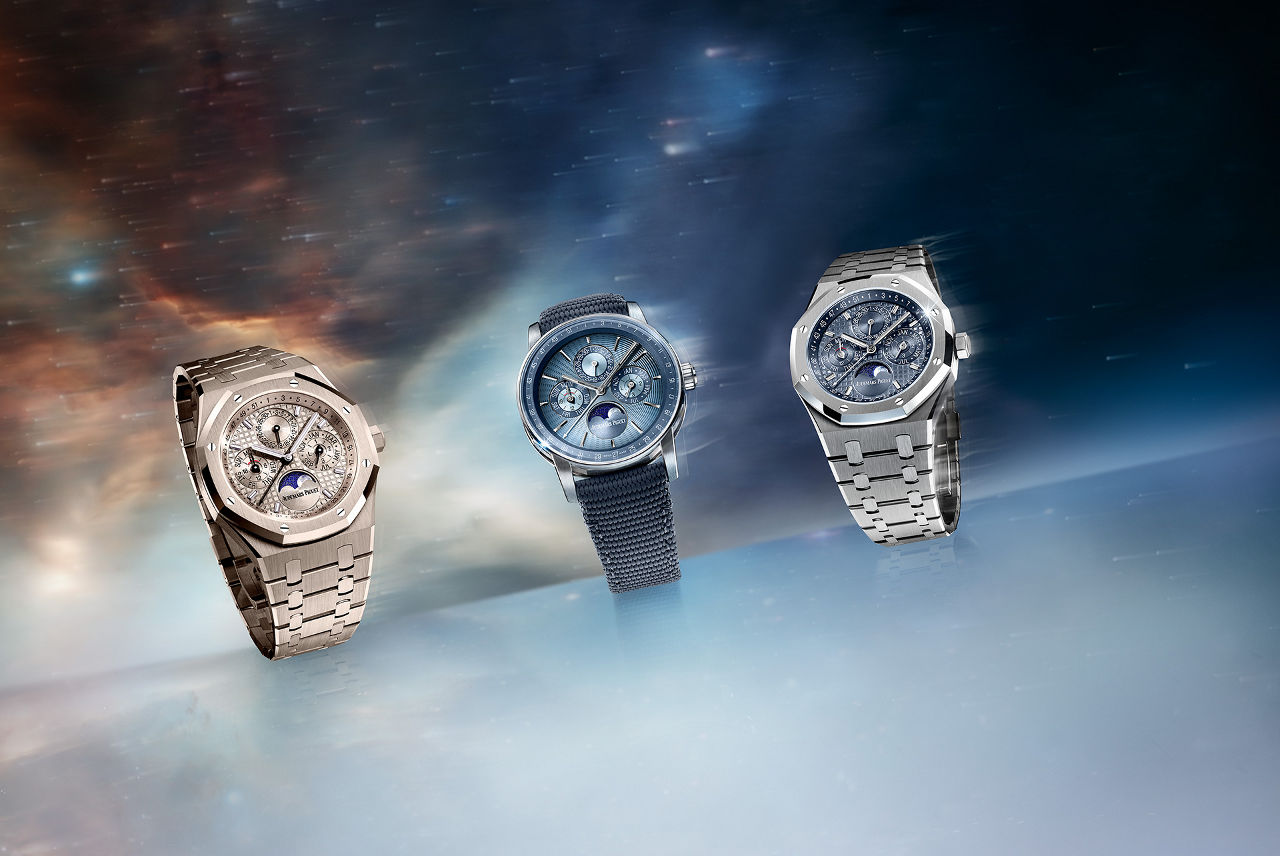A NEW ERGONOMIC PERPETUAL CALENDAR
Audemars Piguet has rethought the perpetual calendar, which mechanically reproduces the movement of the celestial bodies, with ergonomics at its heart to adapt to evolving lifestyles and open up new technical and design avenues.
The result? Three new 41mm selfwinding perpetual calendar references equipped with a movement that allows all functions to be corrected via its "all-in-one" crown.

A COMPLICATION ROOTED IN THE UNIVERSE
Since ancient times, the sun has been our daily timekeeper, while the moon, observable stars and constellations have been our calendars. The rotation of these celestial bodies has served as the basis for the development of timekeeping instruments. Over time, horological devices evolved from sundials and water clocks to highly complicated mechanical clocks and portable watches. The perpetual calendar has captured the imagination of watchmakers for centuries, spurring them to develop ever-more complicated mechanisms to bring us closer to the universe and its cyclic rhythms.
Calendar watches have evolved over time to capture the cycles of celestial bodies with a combination of small cams and gears. Among them, the perpetual calendar – one of the most complex in this category – is like a small mechanical computer on the wrist capable of keeping the date correct for an entire century. Perpetual calendars have marked the history of Audemars Piguet since 1875.
Sébastian Vivas
Heritage and Museum Director, Audemars Piguet
AN ERGONOMIC AND INTUITIVE ALL-IN-ONE CROWN
Building on its heritage and past developments while looking to the future, Audemars Piguet has reimagined the perpetual calendar mechanism with ergonomics in mind.
To enhance user’s experience and streamline the design of the case, AP’s engineers have created an easier and more intuitive correction system entirely controlled via the crown, to make this high complication adjustable anywhere without tools and without risk of damage.
ONE MOVEMENT, THREE AESTHETICS
Calibre 7138 makes its debut on a Code 11.59 by Audemars Piguet and two Royal Oak models, all in 41 mm. The Code 11.59 by Audemars Piguet Selfwinding Perpetual Calendar combines an 18-carat white gold case with the collection’s signature embossed dial in a smoked blue hue. The Royal Oak Selfwinding Perpetual Calendar is available in two distinct aesthetics.
The first pairs a stainless steel case with a blue Grande Tapisserie dial for two-tone elegance. The second, with its 18-carat sand gold case and matching Grande Tapisserie dial, presents a refined monochrome design with unique light effects.

A HARMONIOUS DIAL ENHANCING LEGIBILITY
The dial display follows the European format, with the day at 9 o’clock, the date at 12 and the month at 3. In the same logic, sudials and inner bezel have been harmonised to indicate the first day of the week, the month and the year at noon.
The dial also features a patented date disc with progressive step at 12 o'clock, which adapts to the width of the digits to enhance readability. Lastly, a 24-hour indicator has been incorporated into the day subdial at 9 o'clock, in perfect symmetry with the leap-year indication at 3 o'clock.
A CALIBRE BLENDING TRADITION WITH INNOVATION
Audemars Piguet’s new in-house perpetual calendar movement combines state-of-the-art R&D technology with age-old horological expertise. Calibre 7138 builds on patented innovations launched in 2018 and incorporates all perpetual calendar functions in one single layer within the movement. The end-of-month cam is integrated with the date wheel, while the month cam is combined with the month wheel. Crown corrections form a second layer, enabling the movement to keep a thin 4.1 mm profile.
Calibre 7138 is decorated with refined Haute Horlogerie decorations, including Côtes de Genève, satin-brushing, circular graining and satin, snailing as well as chamfering, all visible on the caseback side.





Calibre 7138 represents a major innovation in the design of perpetual calendars. By placing ergonomics at the heart of our research and development, we have created a unique correction mechanism that allows all adjustments to be made via the crown. In addition to making this high complication easy to use, we also worked on the overall aesthetics to combine high legibility with timeless refinement.
Lucas Raggi
Research and Development Director, Audemars Piguet
Explore the timepieces
Unveiling the secrets of astronomy

Our 150th Anniversary Website
How much do you know about Astronomy ? Discover our Astronomical Observatory and unveil the secrets of time.
Visit the House of Wonders
Revolutionary Ergonomics featuring Caliber 7138
As part of our perpetual calendar launch in 2025, Nicolas Ponsot from our R&D team tells us about the challenges of balancing performance, ergonomics and aesthetics in the design of our new perpetual calendar movement, Calibre 7138.
Read
Astronomy, the mother of watchmaking
Drawing their inspiration from the clear night skies of the Vallée de Joux, generations of Audemars Piguet watchmakers have crafted prestigious timepieces capturing the astronomical cycles of days, months, years and the phases of the moon.
Read
Unveiling the secrets of astronomy
The first complication adopted by the Royal Oak was the calendar. Between 1983 and 1984, the famous octagonal watch was successively enriched with Day-Date, moon phase and perpetual calendar functions.
Read on AP Chronicles
Find a boutique
We invite you to visit our AP Houses and boutiques to explore a variety of Audemars Piguet timepieces and receive expert watch servicing from our skilled professionals, by appointment or walk-in.






?size=1071,515&fmt=avif-alpha&dpr=off)




















